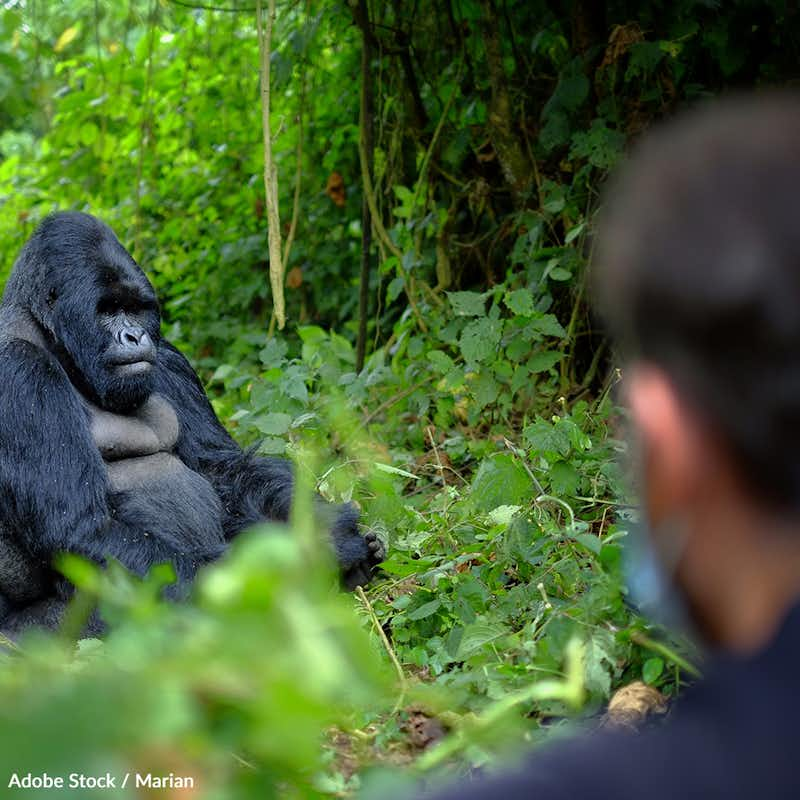Protect The Mountain Gorilla From Habitat Destruction, Poachers and Disease
18,304 signatures toward our 30,000 Goal
Sponsor: The Rainforest Site
Mountain gorillas are threatened by habitat destruction, poaching and disease. Help us take action!

The Mountain Gorilla is one of the 10 most endangered animals on Earth, and it may not be here much longer.
For decades, mountain gorilla populations have been dwindling as uncontrolled hunting, disease, habitat loss and the ravages of human conflict have taken their toll. The mountain gorilla are now considered endangered.
In the 1980s, some estimates counted less than 400 mountain gorillas worldwide. Conservation efforts over the following decades brought the mountain gorilla population to over 1,0001. The International Union for the Conservation of Nature, which sets the conservation status of species, changed the mountain gorilla's status from "critically endangered" to "endangered" in 2008 as their numbers improved2.
There is hope for the future of the mountain gorillas, but they continue to face many serious threats including habitat loss, disease, poaching, and civil unrest.
One longstanding threat to mountain gorillas is from habitat destruction. Farmers in the local human population have been stealing land from the park system for for agriculture3.
Hunting, trading and consumption of gorillas and other apes is considered illegal in all Congo Basin countries, but poachers continue to kill mountain gorillas with little resistance. There simply aren't enough wildlife agents to enforce the national and international laws, and few court systems prepared to prosecute the offenders4.
Human-borne violence is a great threat to mountain gorillas, but disease transmission from humans to primates might drive them back to the brink of extinction.
Gorillas share about 95% of their genetic make up with humans, which makes it easy for diseases to be passed between our species5.
The 1994 outbreak in northern Gabon left nearly every primate dead in what used to be the second largest protected population of gorillas and chimpanzees in the world. Between 2002 and 2003 the virus killed many humans and upwards of 570 gorillas in the Republic of Congo6. The recent Ebola outbreak in West Africa could have originated from infected bushmeat, as well.
Infectious disease accounts for about 20% of gorilla deaths in the wild, the most common being respiratory illness brought over by tourists. This is why tourists who want to see a gorilla in their natural habitat must wear a mask, or risk contributing to more gorilla deaths55.
Despite their recent population growth, the mountain gorilla remains threatened and may remain in danger unless action is taken to protect the species. Sign the petition and help us ask the IUCN Red List to reclassify the mountain gorilla as Critically Endangered and draw greater support to the protection of this disappearing species!
- ScienceBriefss.com (2022), "The Gorilla's Ecosystem."
- International Union for Conservation of Nature and Natural Resources (2022), "Mountain Gorilla."
- International Gorilla Conservation Programme (2022), "Threats."
- World Wide Fund For Nature (2020), "Hunting & poaching."
- Elaisha Stokes, Vice (5 November 2014), "Poaching and Civil War Aren't the Only Threats to Africa's Dwindling Population of Mountain Gorillas."
- World Wide Fund For Nature (2020), "Hunting & poaching."
The Petition:
To the Director General of the International Union for Conservation of Nature and Natural Resources,
Despite their recent population growth, the mountain gorilla remains threatened and may remain in danger unless action is taken to protect the species.
Mountain gorillas are still being killed and slaughtered for meat. Their critical habitat is being clear cut for agriculture. An even greater threat comes from non-violent contact with the animals. Infectious disease accounts for about 20% of gorilla deaths in the wild, the most common being respiratory illness brought over by tourists.
In the 1980s, some estimates counted less than 400 mountain gorillas worldwide. Conservation efforts over the following decades brought the mountain gorilla population to over 1,000.
That momentum coincided with the International Union for the Conservation of Nature's downgrading of the mountain gorilla's status from "critically endangered" to "endangered."
There is hope for the mountain gorilla if we take action now. Please do not allow the success of mountain gorilla programs to blind us to the threats this species still faces. I ask you to reclassify this species as critically endangered and help draw greater international support to efforts to save the mountain gorilla from extinction!
Sincerely,